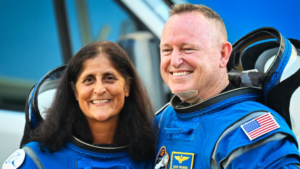Extended space missions, such as the recent nine-month tenure of NASA astronauts Barry “Butch” Wilmore and Sunita “Suni” Williams aboard the International Space Station (ISS), provide invaluable insights into how prolonged exposure to microgravity affects the human body. Upon their return to Earth, these astronauts undergo comprehensive rehabilitation to address the physiological changes incurred during their mission.
Musculoskeletal System: Muscle Atrophy and Bone Density Loss
In microgravity, the absence of gravitational forces leads to muscle atrophy, particularly in the lower extremities and back. Despite rigorous exercise regimens designed to mitigate these effects, astronauts often experience reduced muscle mass and strength, necessitating extensive rehabilitation to regain terrestrial functionality. Additionally, bone density diminishes at a rate of approximately 1-2% per month in space, increasing the risk of fractures and osteoporosis. This bone demineralization poses significant challenges for long-term space travelers, as recovery can be prolonged and may not fully restore pre-flight bone strength.
Cardiovascular System: Fluid Redistribution and Cardiac Remodeling
Microgravity induces a headward fluid shift, resulting in facial puffiness and decreased plasma volume. This redistribution can lead to cardiac muscle atrophy and alterations in heart function. Post-mission, astronauts often face orthostatic intolerance, characterized by dizziness and fainting upon standing, due to the cardiovascular system’s readjustment to Earth’s gravity. These changes necessitate careful monitoring and tailored rehabilitation protocols to ensure cardiovascular health is restored.
Neurological Effects: Brain Structural Changes
Prolonged spaceflight has been associated with structural changes in the brain, particularly the expansion of ventricles—cavities filled with cerebrospinal fluid. A study analyzing astronauts’ brain scans before and after missions revealed significant ventricular enlargement in those who spent six months or longer in space. This expansion could impact cognitive and motor functions, although the long-term consequences remain under investigation. Notably, the study suggests that a recovery period of up to three years may be necessary for the ventricles to return to their pre-flight state, underscoring the need for extended rehabilitation and monitoring.
Ocular Changes: Vision Impairment
Microgravity-induced fluid shifts can increase intracranial pressure, leading to structural changes in the eye, such as flattening of the eyeball and swelling of the optic nerve. These alterations can result in vision impairments, commonly referred to as Spaceflight-Associated Neuro-ocular Syndrome (SANS). Astronauts may experience blurred vision during and after their missions, with some effects persisting for extended periods post-flight.
Radiation Exposure: Increased Cancer Risk
Beyond Earth’s protective atmosphere, astronauts are exposed to higher levels of cosmic radiation, which can damage cellular DNA and elevate cancer risk. The cumulative radiation dose during extended missions necessitates ongoing health surveillance to detect and address potential malignancies early.
Rehabilitation: A Comprehensive Approach
Upon return, astronauts like Wilmore and Williams embark on intensive rehabilitation programs lasting approximately 45 days. These programs focus on restoring muscle strength, bone density, cardiovascular fitness, and neurovestibular function. Therapies include resistance and aerobic exercises, balance training, and activities designed to reacclimate the vestibular system to Earth’s gravity. Continuous medical evaluations ensure that any persistent or emerging health issues are promptly addressed, facilitating a safe transition back to terrestrial life.
Implications for Future Missions
Understanding the physiological impacts of long-duration spaceflight is crucial for planning future missions to Mars and beyond. Developing effective countermeasures to mitigate health risks associated with microgravity and radiation exposure remains a priority. Ongoing research aims to enhance in-flight exercise protocols, nutritional support, and medical interventions to safeguard astronaut health during extended journeys through space.
In conclusion, nine months in space profoundly affect various bodily systems, necessitating comprehensive rehabilitation and continuous research to ensure the well-being of astronauts on future long-duration missions.



